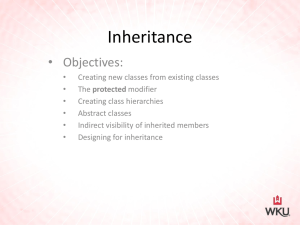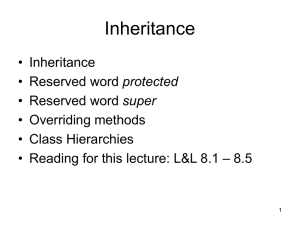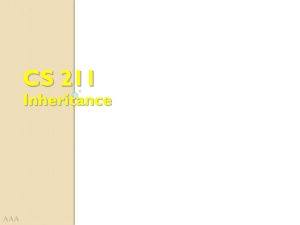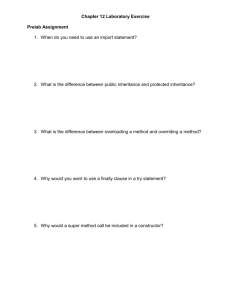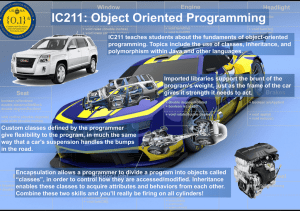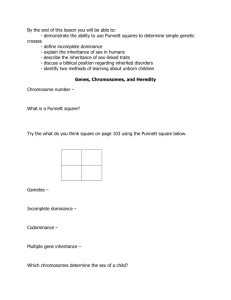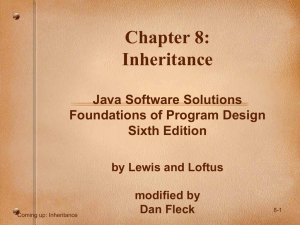Inheritance
advertisement
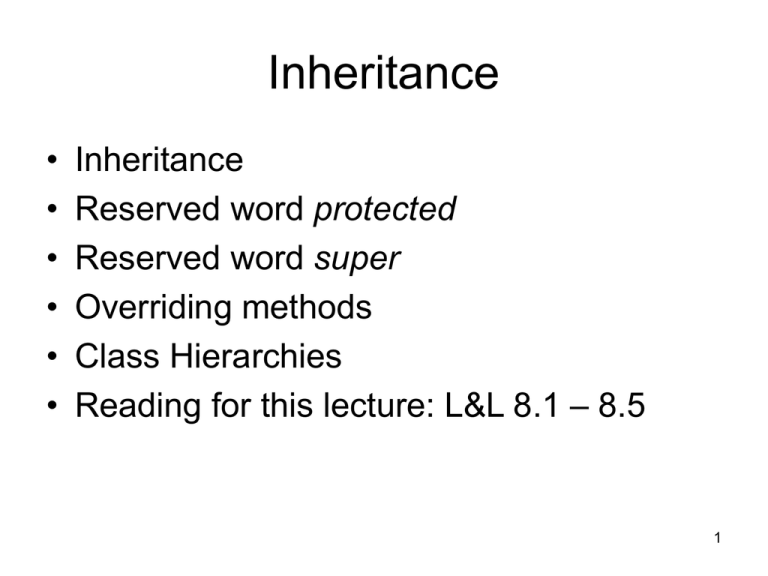
Inheritance
•
•
•
•
•
•
Inheritance
Reserved word protected
Reserved word super
Overriding methods
Class Hierarchies
Reading for this lecture: L&L 8.1 – 8.5
1
Inheritance
• Inheritance allows a software developer to derive
a new class from an existing one
• The existing class is called the parent class,
superclass, or base class
• The new class is called the child class, subclass
or derived class
• As the name implies, the child inherits
characteristics of the parent
• That is, the child class inherits the methods and
data defined by the parent class
2
Inheritance
• Inheritance is based on an is-a relationship
• The child is a more specific version of the parent
• Inheritance relationships are shown in a UML
class diagram using a solid arrow with an unfilled
triangular arrowhead pointing to the parent class
(Note: Similar graphic notation as Interface)
Vehicle
Solid line
instead of
dotted line
Car
3
Inheritance
• Software reuse is a fundamental benefit of
inheritance
• By using existing software components to create
new ones, we capitalize on all the effort that
went into the design, implementation, and
testing of the existing software
• However, a programmer can tailor a derived
class as needed by adding new variables or by
“overriding” some of the inherited methods
4
Deriving Subclasses
• In Java, we use the reserved word extends to
establish an inheritance relationship
public class Car extends Vehicle
{
// class contents
}
5
The protected Modifier
• Visibility modifiers affect the way that class
members can be used in a child class
• Variables and methods declared with private
visibility cannot be referenced by name in a
child class
• They can be referenced in the child class if they
are declared with public visibility -- but public
variables violate the principle of encapsulation
• There is a third visibility modifier that helps in
inheritance situations: protected
6
The protected Modifier
• The protected modifier allows a child class to
reference a variable or method directly in the
child class
• It provides more encapsulation than public
visibility, but is not as tightly encapsulated as
private visibility
• A protected variable is visible in any class that is
a child of the class where it is defined
• A protected variable is also visible in any class
that is in the same package as the class where it
is defined (we don’t use packages in this course)
• Protected variables and methods can be shown
with a # symbol in UML class diagrams
7
Class Diagram for Words
Book
# pages : int
+ pageMessage() : void
Words
Dictionary
- definitions : int
+ main (args : String[]) : void
+ definitionMessage() : void
8
The super Reference
• Constructors are not inherited even though they
have public visibility
• Yet we often want to use the parent's constructor
to set up the "parent's part" of the object
• The super reference can be used to refer to the
parent class and invoke the parent's constructor
public class Child extends Parent
{
public Child()
{
super();
// a call to Parent()
// plus whatever code we need for Child
}
}
9
The super Reference
• A child’s constructor is responsible for
calling the parent’s constructor
• The first line of a child’s constructor should
use the super reference to call the
parent’s constructor
• The super reference can also be used to
reference (with a dot .) other variables and
methods defined in the parent’s class
10
Multiple Inheritance
• Multiple inheritance allows a class to be derived
from two or more classes inheriting members of
all parents
• Collisions (such as the use of the same variable
name in two or more parents) must be resolved
• Java does not support multiple inheritance
(Some other languages such as C++ do)
• In Java, a class can have only one direct parent
• The use of interfaces in Java gives us most of
the benefits of multiple inheritance without the
problems
11
Overriding Methods
• A child class can override the definition of an
inherited method in favor of its own
• The new method must have the same signature
as the parent's method, but can have a different
body
• The class of the object used to execute an
overridden method determines which version of
the method is invoked
• In the child, the method in the parent class can
be invoked explicitly using the super reference
• If a method is declared in the parent class with
the final modifier, it cannot be overridden
12
Overriding Variables
• The concept of overriding can be applied
to data and is called shadowing variables
• Shadowing variables should be avoided
because it tends to cause unnecessarily
confusing code
13
Overloading vs. Overriding
• Overloading deals with multiple methods with the
same name in the same class that have different
signatures (different parameter lists)
• Overriding deals with two methods (one in a parent
class and one in a child class) that have the same
signature (same parameter list)
• Overloading lets you define a similar operation in
different ways (using different input parameters)
• Overriding lets you redefine a parent’s method in a
child (using the same input parameters)
14
Class Hierarchies
• A child class of one parent can be the parent of
another child, forming a class hierarchy
• Two children of the same parent are called
siblings
Business
RetailBusiness
KMart
Macys
ServiceBusiness
Kinkos
15
Class Hierarchies
• A child class inherits from all its ancestor
classes
• An inherited variable, constant, or method is
passed continually down the line (unless it is
declared private)
• Common features should be put as high in
the hierarchy as is reasonable
• There is no single class hierarchy that is
appropriate for all situations
16
The Object Class
• A class called Object is defined in the java.lang
package of the Java standard class library
• All classes are derived from the Object class
• If a class is not explicitly defined to be the child of
an existing class, it is assumed to be the child of
the Object class
• Therefore, the Object class is the ultimate root of
all class hierarchies
17
The Object Class
• The Object class contains a few useful
methods which are inherited by all classes
• For example, the toString method is defined
in the Object class
• The toString method in the Object class is
defined to return a string that contains the name
of the object’s class along with other information
(e.g. the address of its location in memory)
System.out.println(new Object());
java.lang.Object@952905
• Every time we define the toString method, we
are actually overriding the inherited definition 18
The Object Class
• The equals method of the Object class
returns true if the two references are aliases
• We can override equals in any class to define
equality in some more appropriate way
• As we've seen, the String class defines the
equals method to return true if the two String
objects contain the same characters
• The designers of the String class have
overridden the equals method inherited from
Object in favor of a more useful version
19
Abstract Classes
• An abstract class is a placeholder in a class
hierarchy that represents a generic concept
• An abstract class cannot be instantiated, it can
only be extended in a class hierarchy
• We use the modifier abstract on the class
header to declare a class as abstract:
public abstract class Product
{
// contents
}
20
Abstract Classes
• An abstract class often contains abstract
methods with no definitions (like an interface)
• Unlike an interface, the abstract modifier
must be applied to each abstract method
• Also, an abstract class typically contains some
non-abstract methods with their full definitions
• A class declared as abstract does not have to
contain abstract methods -- simply declaring it
as abstract makes it so
21
Abstract Classes
• The child of an abstract class must override all
abstract methods of the parent or it too will be
considered abstract
• An abstract method cannot be defined as final
or static
• The use of abstract classes is an important
element of software design – it allows us to
establish common elements in a class hierarchy
that are too generic to instantiate
22
